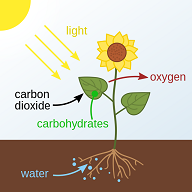In nature, energy is free and always in ample supply. The sun delivers an energy flow to our planet of which we only use a few percent. Nature can perform all its wondrous works through micro technology, using just 1% of its ambient energy,

Our problem is: how do we get hold of this large supply? Nature developed a very complicated system to that end, photosynthesis. A system that is still the subject of our investigations; and that doesn’t stop us wondering why it is so inefficient. The plant can process just a fraction of the energy delivered to it for useful applications; 0.1 to 2%, depending on the colour. But its consequences are very interesting. In nature, energy is a precious property that needs to be used as efficiently as possible. Thanks to catalysis and enzymes, nature can construct the most intricate (life) forms – and let them function.
Nature is extremely economical
There is a parallel with minerals like nitrogen, that nature needs in order to construct amino acids, proteins and DNA. Our atmosphere contains more than 70% nitrogen (N2 in a non-usable form), but through micro technology nature can change that nitrogen into a usable form. Again, thanks to enzymatic catalysis; nature treats very efficiently and subtly the nitrogen that she obtains with so much difficulty. If mankind intervenes by supplying nature with easily extractable nitrogen (manure and/or fertilizer), this works well in the first instance. Nature accepts our offer and rewards us with much better yields and more and better food (the Green Revolution). But as always: too much of ought is good for nought. The subtle systems, tuned to scarcity, get off their strokes. Starting with the most vulnerable ones, for these are tuned towards the scarcest conditions. Take the Nepenthes Rajah, that obtains its nitrogen from the manure of a rat trapped in its calyx – but that will surely die upon a tiny bit of fertilizer. Compare it to the world record high jump. Each small change in its conditions will almost always prevent new records.

What does this teach us? Again: too much of ought is good for nought – it is general scarcity that keeps a living planet alive. Micro technology! We know now how to handle the most important parameters, like energy and nitrogen, making use of solar energy. Our solar panels, much easier to construct than the photosynthesis complex, can reap solar energy with a high efficiency. Whereas nature scores about 1%, our panels can easily score a 20% efficiency; and more lies in store for us in the future.
Micro technology
Much in the realm of micro technology belongs to our toolkit now. Like information technology and presently also artificial intelligence. With a minimum of effort, we can deliver a multitude of results, just like nature does. In nature, the process is often step by step; also including many repeats (remember fractals in biosynthesis that eventually end up in, for instance, flower motifs). But even for us, that might not pose a major problem in the near future. Soon, we will be able to separate gold, silver or rare earth metals from waste by using micro technology. We may need millions of little steps, and these may cost a lot of energy. But if done by a smart micro machine with a little solar panel of its own, a yield of just a few grams a day may still be worthwhile. We will simply put a few thousands of those devices at work. The little machine might even be a microorganism.

So, here’s the parallel with the world of microorganisms, precision fermentation, synthetic biology and cellular agriculture. We know by now the genetic codes for any naturally occurring material; and we increasingly master the art of transferring it to a suitable micro-organism, for mass production. Remember cultured meat and animal-free dairy products. And penicillin, produced by transferring the mould’s code to the cells of ordinary yeast. And yeast is much easier to handle than a mould! Remember the antimalarial medicine artemisinin from the Artemisia Annua herb; its code, transferred to the E.coli bacterium, now produces hundreds of kilograms per day effortlessly. Properly speaking, there are no impediments to doing the same sort of thing for whatever natural product!
The new challenge
In other words: let’s do the same for cotton, cellulose, starch, wood, lignin etc. etc. If we succeed in processing cotton etc. through micro technology (or produce it artificially), we will also be able to create new properties in it. As a result, we will need much less the use of plastics. Therefore, with micro technology, we will minimize attacks on nature, land and water – just like we do by creating cultured meat. For all applications, sugar from agriculture will be the most important resource. We formulated earlier: ‘sugar will become the new oil’. And there is more to come. With techniques like CRISPR-Cas, we succeed better all the time in changing DNA codes, and hence change the properties of natural products. For instance, produce thicker cotton, or coloured cotton. Or produce softwood that hardly rots; or for that matter, hardwood that weighs less. It is a major scientific challenge to translate the required properties of artificial materials to changes in the genetic code for a natural product. Like: the transfer of the advantages of polyesters to the cotton itself, without damaging cotton’s natural compatibility.
In introducing genetically modified cotton plants, we already embarked on this road. At present, the goal of the operation is to protect cotton from all sorts of diseases; but the step towards modifications in the end product doesn’t need to pose many problems. And we might even do this more easily. Start from the natural product and then modify it. For cotton, we made the first steps already.
Wood as a construction material
If we apply these principles to the use of wood as a construction material, the developments are quite revolutionary. A major change has taken place in the construction industry: the development of mass timber, the technical term for industrial timber. It allows for the construction of innovative buildings. Mass timber as a construction material can now even outperform bricks, concrete and steel in terms of cost, sustainability and wellbeing. For with modern technology, we can now treat solid wood in order to increase its durability. With such treatments, softwood will get many of the properties of hardwood. Among these techniques are treatment with acetic anhydride under pressure (acetylation). Or with furfuryl alcohol, a side product of cane sugar production (furfurylation). Or just by heat treatment.

One of the most widely used techniques results in glue laminated timber (glulam). This consists of several softwood boards, glued together with parallel fibres. Pieces with knots and other small defects are removed, which results in a strong beam. As each of the rather thin boards can be bent, glulam may be used to produced curved forms. The beams look somewhat like solid wooden beams, but they are stronger and can be made very long, up to 80 metres. Another widely used product is cross laminated timber. Here, the fibres are glued in perpendicular directions. The material is very well suited for the production of large flat surfaces like floors. Industrially produced wood renders much freedom of design.
Holism
This is holism in the world of materials. Start from the complexity of the whole. Make subtle changes through micro technology without damaging the whole, but with the desired property as an extra. But it is very unlikely that we’ll get there if we start from a synthetic material. Then, is a few years, we would have to walk the million year’s road of cotton’s evolution in a few years of lab experiments. Let’s be sensible and start from the natural product.
Surprises
Will there be disadvantages? No doubt. We will also run into surprises. Maybe, the products of precision fermentation differ just a little from the natural product, because we made minute mistakes in transferring the genetic code. Or because we didn’t transfer that code in its entirety because we undervalue certain bits and pieces (because of our reductionistic attitude). Or because we didn’t include some essential ‘byproducts’ in the genetic code. Nature almost never uses 100% pure substances. Its products are mixtures, almost always (remember fragrances and flavourings). Maybe some micro ingredients are essential for an optimal function. After all, we deal with holism!
The concept that 100% pure and simple compounds qualify all properties, is an axiom typically belonging to the world of reductionism. This is a problem, for instance in the development of cultured meat. In order to arrive at the proper taste and mouthfeel, we need just a bit more than many muscular cells put together. But what do we need to add? And how much of it? And where do we find the genetic codes? Or should we add something to the cultured product, maybe causing new problems? Or alternatively, maybe our cultured food is too clean, causing our immune system to get upset? If we start eating cultured meat, we will no longer ingest unfamiliar proteins, bacteria or viruses. Which do abound in our present food, in spite of all hygienic measures. Our immune system might lose its memory! And what may happen with our intestinal flora, if we ingest ever more ‘clean’ food? Our reductionist attitude will produce pure, unambiguously produced food; but even so, it may conflict with the natural product, arrived at in a holistic way. We will not walk this road surprise-free.
Interesting? Then also read:
Respectful treatment of the complexity of biomass
Wood conservation
Lignin processing – challenges and limits
